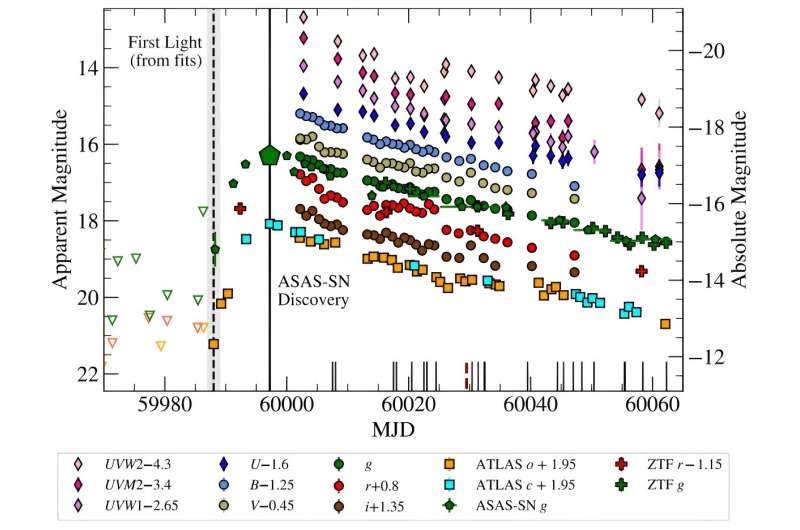January 18, 2024 report
This article has been reviewed according to Science X's editorial process and policies. Editors have highlighted the following attributes while ensuring the content's credibility:
fact-checked
preprint
trusted source
proofread
Astronomers detect new faint tidal disruption event

An international team of astronomers reports the detection of a new tidal disruption event (TDE) as part of All-Sky Automated Survey for SuperNovae (ASAS-SN). The newfound TDE, designated ASASSN-23bd, turns out to be the least luminous and the lowest redshift TDE known so far. The finding is reported in a paper published January 10 on the pre-print server arXiv.
TDEs occur when a star passes close enough to a supermassive black hole and is pulled apart by the black hole's tidal forces, causing the process of disruption. Such tidally disrupted stellar debris starts raining down on the black hole and radiation emerges from the innermost region of accreting debris, which is an indicator of the presence of a TDE.
Observations conducted by a group of astronomers led by Willem Hoogendam of the University of Hawaii have found a new TDE in NGC 3799—an active barred spiral galaxy located some 300 million light years away. ASASSN-23bd (AT 2023clx) was detected in February 2023 at a redshift of 0.011.
"ASAS-SN discovered ASASSN-23bd (a.k.a. AT 2023clx2) on MJD 59997.2 at (????, ????) = (11:40:09.397 +15:19:38.54) in NGC 3799 using the Cassius unit in Chile," the researchers wrote in the paper.
ASASSN-23bd peaked on February 25, 2023, with a peak ultraviolet/optical luminosity of about 5.4 tredecillion erg/s, and a near peak X-ray upper limit of 17.5 duodecillion erg/s. The TDE displayed hydrogen-alpha emission throughout its decline and helium emission near peak and shortly after the peak.
The observations indicate that the black hole of ASASSN-23bd has a mass of about one million solar masses. The TDE's host, NGC 3799, appears to be still undergoing star formation and hosts weak active galactic nucleus (AGN) activity.
Based on the results, the astronomers concluded that ASASSN-23bd is the lowest redshift and the least luminous TDE detected to date. Moreover, ASASSN-23bd exhibited a rapid light curve rise—of less than 15 days. This makes it one of the low luminosity and fast (LLaF) tidal disruption event.
The researchers added that due to its low luminosity, ASASSN-23bd may not have been detected if it were not so close to the Earth.
"In this sense, ASASSN-23bd is a fine but fortunate addition to the collection of LLaF TDEs," the authors of the study wrote.
Hoogendam's team hopes that more LLaF TDEs like ASASSN-23bd could be discovered by deeper sky surveys, which can be conducted by facilities such as the Large Synoptic Survey Telescope (LSST). Astronomers predict that LSST is capable of identifying about 1,000 TDEs per year.
More information: W. B. Hoogendam et al, Discovery and Follow-up of ASASSN-23bd (AT 2023clx): The Lowest Redshift and Least Luminous Tidal Disruption Event To Date, arXiv (2024). DOI: 10.48550/arxiv.2401.05490
Journal information: arXiv
© 2024 Science X Network





















